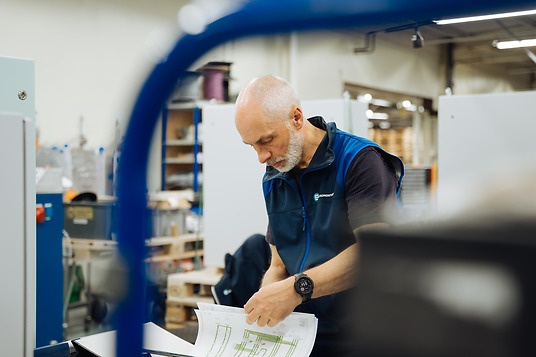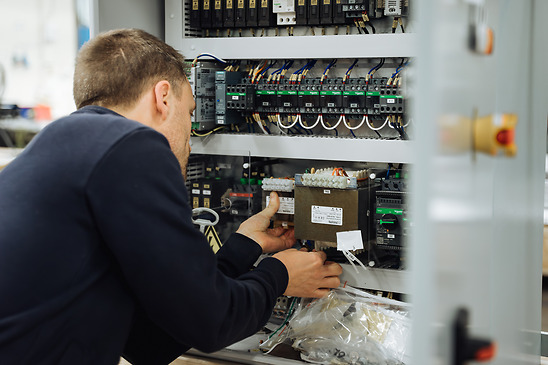
During the early electrification of our society, electricity was employed across various domains, with illumination being one example. However, the most significant transformation occurred within the industrial sector. Harnessing electricity to power machinery yielded tremendous benefits in comparison to steam engines and other mechanical systems. An ongoing challenge, faced by machinery manufacturers even today, is the substantial energy demand during startup. Consequently, numerous methods, referred to as "starters," have been developed over the years to initiate electric pumps, machinery, and other functions.
Elektromontage has extensive experience in the design and production of starting equipment and motor control centers for various applications, ranging from small pumps with just a few kW to large propeller equipment with several MW. We can supply individual starting equipment and/or complete motor control centers that are fully certified, including direct start, YD start, soft start, and frequency converters in power ranges from 4kW/1000V up to 3MW/11.4kV.
All equipment can be classified by: DNVGL, BV, LRS, ABS, NKI, and CCS.
A soft starter is an electronic starting function where energy consumption during startup is limited, and voltage gradually increases until the operating voltage is reached. The time this takes can vary depending on the application's requirements. A frequency inverter is an electronic control function that regulates an electric motor by adjusting both frequency and voltage in the power supply. It can also control ramp-up and ramp-down during start and stop. Elektromontage represents the soft starter manufacturer Solcon in Sweden.
A soft starter reduces wear and tear on transmissions, shafts, and bearings with each start. Wear and tear is significantly reduced, especially in large starting equipment where there is often a large mass to be set in motion at the moment of startup.
Service costs often decrease dramatically, and equipment availability increases with a soft starter. Solcon has a long reference list of advanced soft starter deliveries for both low and high-voltage installations.
A simple pump starter is a feature designed to activate pump functions in a straightforward and reliable manner while minimizing the strain on the power grid. This can be achieved through techniques like Y/D-start, soft starting, or frequency conversion, contingent on customer preferences. In larger applications such as ship propulsion systems, the possibilities are more restricted. Here, meticulous design is required to initiate the machinery as energy-efficiently and weight-optimized as possible, taking into account the generator, electrical system, and onboard weight constraints.
An auto-transformer starter is a tried-and-true starting method involving substantial alternating contactors and temporarily elevated voltage in the motor circuit. The aim is to mitigate current spikes during startup and acceleration. Often, this approach is more cost-effective than electronic solutions.

All these variations of starting systems, coupled with classification requirements, national standards, and the demanding operational environment, influence the necessary design. Elektromontage has acted as a supplier of various starting systems for many years and thus serves as a dependable partner in these matters. Their starters have been supplied to a multitude of marine applications, encompassing both civilian and military contexts, where stringent demands have been placed on design and performance.
We can supply from 4kW up to 1750kW/230-1000V and from 0.2MWA to 21.8MWA/2.3-13.8kV.
The primary difference between a Soft Starter and a Variable Frequency Drive (VFD) lies in their functions. A Soft Starter gradually ramps up the voltage to reduce inrush current and torque, which protects the motor during startup and shutdown. It is ideal for fixed-speed applications where speed control is not required. A VFD, however, provides full control over motor speed and torque by adjusting the frequency and voltage of the power supply, making it suitable for applications where precise speed adjustments are necessary. VFDs offer greater flexibility but are typically more complex and costly than soft starters.
Soft starters are known for their reliability due to their straightforward design and functionality. They provide a cost-effective solution for applications requiring smooth motor startups without the complexity of full-speed control. Their simplicity translates to fewer potential points of failure, making them a reliable choice for systems where variable speed control is unnecessary. For fixed-speed applications, soft starters are durable, effective, and cost-efficient, often lasting many years with minimal maintenance.
A conventional motor starter applies full voltage to the motor immediately at startup, resulting in a high inrush current and an abrupt surge in torque. This sudden rush can strain electrical circuits and cause mechanical stress on the motor, which can lead to wear over time. A soft starter, however, gradually ramps up the voltage supplied to the motor, reducing inrush current and torque and providing a gentler, controlled start. This controlled approach helps prevent circuit overloads, enhances motor lifespan, and is particularly useful in applications where equipment starts and stops frequently.
A pump starter is a specialized starter designed to safely start and control pump motors, commonly used in industrial and agricultural settings for applications such as sewage handling, water treatment, and irrigation. Pump starters provide essential protection by controlling the starting current and ensuring smooth motor operation, often including overload protection features tailored to the demands of pump applications. These starters are designed to protect motors from damage due to high inrush currents, prolonging the motor’s lifespan and enhancing reliability without the need for additional fuses.
Pumps require starters to safely manage the high inrush currents and torque produced during startup, which can otherwise damage the motor or electrical system. Starters help regulate the initial voltage applied to the motor, preventing sudden surges that could overload circuits or cause mechanical stress. Additionally, many pump starters include protection features to detect voltage fluctuations or electrical faults, which can automatically shut down the pump to prevent damage. This added protection is essential in maintaining pump reliability and extending the equipment's lifespan, particularly in high-demand applications like water treatment and irrigation.
The primary purpose of an autotransformer is to adjust voltage levels efficiently in both industrial and commercial applications. Unlike traditional transformers, autotransformers use a single winding that serves as both primary and secondary, making them more compact and cost-effective. They are commonly used to step up or step down voltage for machines like motors, compressors, and CNC equipment, where precise voltage control is critical. This setup provides stable power supply while minimizing energy loss and costs, making autotransformers ideal for applications requiring reliable voltage regulation.
An autotransformer starter works by reducing the voltage supplied to a motor during startup, which in turn reduces the inrush current and provides a gentler startup. When the motor is first activated, the autotransformer steps down the voltage, limiting the initial current to avoid sudden surges. As the motor accelerates, the autotransformer gradually allows a transition to full line voltage, completing the startup process. Autotransformer starters are commonly used in applications where smooth acceleration is needed, but without the complexity of a Variable Frequency Drive (VFD). They are especially useful for motors with high starting torque requirements.
The primary difference between Star-Delta starters and Soft Starters lies in their flexibility and control over the motor starting process. Star-Delta starters initially connect the motor windings in a star configuration, then switch to a delta configuration as the motor reaches a certain speed. This method reduces inrush current but provides limited control, and starting torque cannot be adjusted to match specific load characteristics. Soft Starters, however, offer a smoother and more customizable start by gradually increasing voltage to the motor, reducing mechanical stress and inrush current without causing transients. Soft Starters allow for greater control over torque, making them ideal for applications with varying load conditions or frequent start-stop cycles.